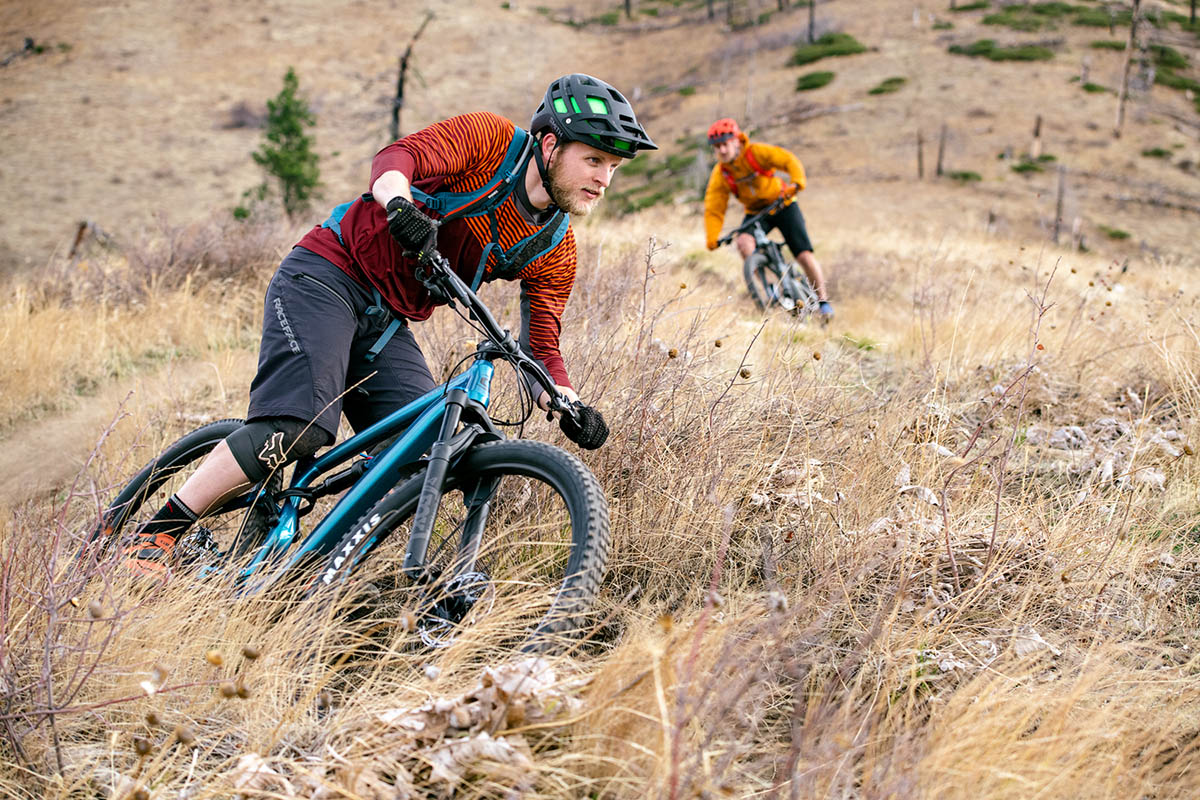
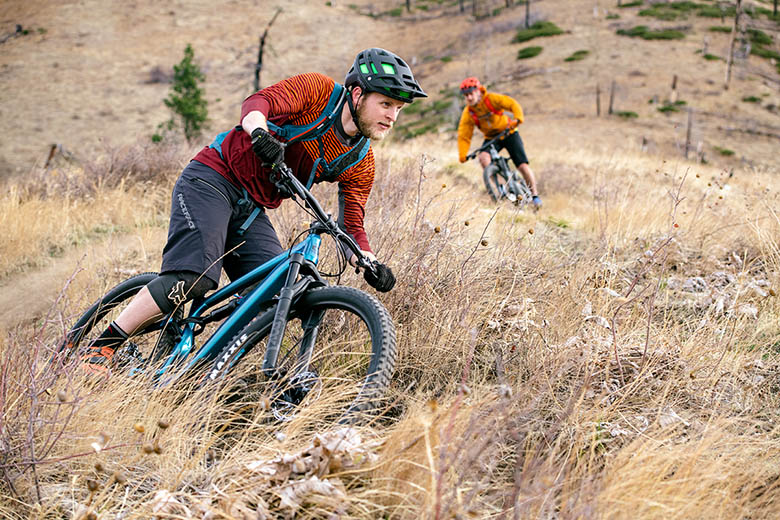
Switchback Travel (Jason Hummel)
From smooth and flowy post-work rides to rough and rowdy all-day backcountry epics, the trail mountain biking category covers a wide range. And with rapidly changing technology and an ever-growing number of options, it can be hard to nail down the best ride for your needs. We’ve been testing designs from beginner-oriented hardtails to fast and fun full-suspension rigs since 2021, and below we outline our top seven picks for 2024 broken down by type and best use. Finally, we firmly believe your mountain bike should cost less than a down payment on a house, so we’ve capped the price at $6,000 on sale. For more background information, see our buying advice and comparison table below the picks.
Editor’s note: This guide was updated on June 26, 2024, with an overhauled list of picks to reflect 2024 offerings. We also included information about our testing practices and swept the guide to ensure all information was up-to-date at the time of publishing.
 Frame: Carbon
Frame: Carbon
Suspension: 150mm (front) 145mm (rear)
Tires: 29 x 2.4 in.
What we like: A hard-charging workhorse that excels on almost all terrain.
What we don’t: A bit heavy and expensive; not as strong a climber as a shorter-travel bike.
With high-end bikes growing increasingly expensive each year—four on this list alone are $5,000 or more—it’s no wonder that lots of folks are looking for one bike to do it all. Santa Cruz’s Hightower is exactly that: a well-rounded and highly capable rig that can handle almost any terrain you throw its way. Highlights include a reasonably light carbon build, a fantastic SRAM GX Eagle drivetrain, 29-inch tires that smoothly roll over rocks and roots, and a just-right amount of suspension (150mm up front and 145mm in the back) to balance long stints of uphill pedaling and steep, technical descents. In short, the Hightower is a point-and-shoot downhill machine that doesn’t skimp on climbing performance, striking a hard-to-beat balance for many riders.
Santa Cruz does have a reputation for high prices, and the Hightower is no exception. That said, the brand’s lifetime warranty on its frames is one of the best in the business, and the bike is built to last with high-quality components throughout. It’s not the strongest climber out there—for that, we turn to lighter and more flickable designs like Yeti’s SB135—but the Hightower puts it all together better than most at a much cheaper price point than the Yeti, earning it our top spot this year. It’s also worth noting that you can upgrade to a smoother, more consistent, and easier-to-maintain wireless drivetrain (with the GX AXS build kit) for $5,599 at the time of publishing.
See the Santa Cruz Hightower S
 Frame: Carbon
Frame: Carbon
Suspension: 160mm (front) 150mm (rear)
Tires: 29 x 2.3 in. (front), 27.5 x 2.3 in. (rear)
What we like: A playful and capable downhill companion; uniquely adjustable build for nearly any riding style.
What we don’t: Downhill prowess comes with drawbacks in weight, price, and versatility; mullet setup is polarizing.
The Stumpjumper has a storied history in the world of cycling: It was the first mountain bike made for the masses and helped popularize the sport, and Specialized has had decades to dial in overall performance and refinement. The mid-range Evo Expert T-Type model is a real winner, particularly for those who put a premium on downhill prowess. Compared to the Hightower above, the Stumpjumper offers a bit more squish, along with a mullet setup—a 29-inch tire up front and 27.5-inch tire in the back—for added playfulness on the descent. And we’d be remiss not to mention the adjustable geometry, which offers the ability to fine-tune the head tube angle (by 2 degrees) and bottom bracket height (by 10mm) to suit your needs and riding preferences.
What’s not to like with the Specialized Stumpjumper Evo Expert T-Type? In addition to the steep $6,300 price tag, the bike is no featherweight at nearly 33 pounds and not a particularly strong climber—if gnarly downhills aren’t at the top of your priority list, there are plenty of more well-rounded options to consider, many of which are cheaper (including the Hightower above). The mullet setup is also a little polarizing and does take some getting used to, although we’ve come to love the best-of-both-worlds compromise. For a similarly burly option at a slightly cheaper price point, we also love Santa Cruz’s Bronson ($5,899), although the Stumpjumper Evo gets the slight edge in overall refinement with a higher-quality fork and shock. Again, it’s not the best all-rounder out there but is an excellent tool for soaking up bumps on technical terrain and hitting features at your local bike park.
See the Specialized Stumpjumper Evo Expert T-Type
 Frame: Carbon
Frame: Carbon
Suspension: 130mm (front) 120mm (rear)
Tires: 29 x 2.4 in (front), 29 x 2.35 in. (rear)
What we like: Wildly light and fast—great for long, pedal-heavy days in the saddle.
What we don’t: Pricey and not the best downhill companion.
One of the latest buzzwords in mountain biking, “downcountry” bikes are purpose-built for efficiency, with lightweight carbon frames, trail-friendly geometry, and shorter travel than all-rounders like the top-ranked Santa Cruz Hightower (they're essentially more downhill-friendly XC rigs, hence their name). In other words, whereas the options above emphasize downhill performance, these bikes are all about the up. The Epic 8 Evo Comp from Specialized is our current favorite in this growing category. Listed at around 28 pounds (for a medium frame), it’s a competitively light and fast build that nicely blends the agility and speed of a cross-country rig with the capability of a trail bike. In sum, it’s an ideal companion for big days in the alpine, snagging local singletrack KOMs on Strava, or if your local terrain involves a lot of long, pedal-intensive climbs.
Other than sacrificing some downhill performance for climbability, the biggest downside here is cost: Specialized bikes don’t come cheap, and the Epic Evo 8 Comp is a relatively steep investment at $5,000. If you’re on a tighter budget, consumer-direct pioneers Canyon and YT Industries also make compelling—and more wallet-friendly—alternatives in their Lux Trail and Izzo, respectively. Regardless of which option you choose, we think of downcountry bikes as the MTB equivalent to skimo skis: You can put some serious uphill miles on them, and they’re decently capable descenders, too. But for those looking for best-of-both worlds performance, we’d opt for a heavier and beefier option like the Hightower or Specialized’s own Stumpjumper above.
See the Specialized Epic 8 Evo Comp
 Frame: Aluminum
Frame: Aluminum
Suspension: 130mm (front)
Tires: 29 x 2.6 in.
What we like: A strong performer for everything from after-work singletrack rides to remote bikepacking adventures.
What we don’t: Beefed-up construction adds weight; inherently a rougher ride than a full-suspension bike.
Minnesota-based Salsa Cycles is best known for their bikepacking, touring, and gravel-oriented designs, but they’ve made some serious headway in mountain biking of late. Their Timberjack XT 29 hardtail is a case in point with its well-thought-out spec package and adaptable design. The bike’s burly 2.6-inch tires and highly adjustable 130-millimeter RockShox 35 Gold RL fork provide more than enough cushion for rocky and rooty descents (by hardtail standards). And the relatively slack geometry and fast-rolling tires encourage shenanigans like popping off trailside lips and manualing down the trail. What we really like about the Salsa, however, is its nod to bikepacking: You simply won’t find too many other hardtails that offer as many mounting locations for gear as the Timberjack.
What’s not to like with the Salsa Timberjack XT 29? For starters, the burly construction and wide tires mean the bike isn’t as nimble or fast as a more cross country-focused design. Even a comparable option like Santa Cruz’s Chameleon, which has the same amount of travel but checks in a few pounds lighter and features a mullet setup, is noticeably more playful. And it almost goes without saying that a full-suspension rig will be the more comfortable ride when the going gets rough. But again, the Timberjack is a very solid performer that’s built to last, and it will save you a good chunk of cash over an equivalent full-suspension design (rear suspension is spendy). Bonus: It's available through REI, which means there's a good chance you'll be able to try it out before you buy—not to mention, co-op members get a year of free adjustments, the option for free in-store assembly, and 20% off shop services, among myriad other benefits.
See the Salsa Timberjack XT 29
 Frame: Aluminum
Frame: Aluminum
Suspension: 160mm (front) 150mm (rear)
Tires: 29 x 2.6 in. (front) 27.5 x 2.6 in. (rear)
What we like: A well-rounded e-bike with a strong, long-lasting battery and refined downhill performance.
What we don’t: Heavy, expensive, and many trail systems don’t allow e-bikes (yet).
Specialized has been at the forefront of electric mountain bikes in North America, and their Turbo Levo is a leading all-mountain design. The latest bike is a real grin-maker—trust us on this one—and received a host of improvements that set it apart. Its mullet setup (a 29-in. wheel at the front and 27.5-in. wheel at the back) gives it a balanced and easy-to-control feel but still can smash through technical terrain, and its electronics have seen nice upgrades in durability and refinement over the years. Plus, like Specialized’s Stumpjumper Evo above, the Turbo Levo Comp offers the ability to tweak the head tube angle and bottom bracket height to dial in the geometry to your preferences. Overall, among a fast-growing and competitive field of e-mountain bikes, we think the latest Turbo Levo is at the top of the list.
Currently, the biggest barrier to an e-mountain bike of any kind is price. Despite packing an aluminum frame, the Turbo Levo Comp here costs a steep $7,000, and carbon models start at a whopping $9,000. Additionally, the extra drive system adds a significant amount of weight—it’s not uncommon for e-bikes to weigh upwards of 50 pounds or more (for reference, the Turbo Levo Comp is around 52.5 lb.). This added heft also has performance drawbacks, and we’ve found the Turbo Levo is quite a bit less flickable and more reluctant to get off the ground than the brand’s analog Stumpjumper Evo (or the lighter but less powerful Levo SL e-bike). Finally, land managers and lawmakers are still trying to figure out where e-bikes fit into outdoor recreation. Regulations vary by state and riding area, but oftentimes they technically are not legal to ride on singletrack trails (although we’re seeing increased access each year).
See the Specialized Turbo Levo Comp Alloy
 Frame: Aluminum
Frame: Aluminum
Suspension: 140mm (front) 135mm (rear)
Tires: 29 x 2.5 in.
What we like: An excellent all-rounder at a hard-to-beat price.
What we don’t: You can get similar performance for less in the consumer-direct space (if you're willing to deal with some downsides).
There’s no way around it: Full-suspension bikes are an expensive breed. Fortunately, we’ve started to see high-end tech trickle down into the cheaper end of the market, and there are currently several competitive options for under $3,000. The Ari Cascade Peak Pro is a case in point. At $2,999 full MSRP and $2,799 on sale at the time of publishing, the Cascade is by no means cheap but offers a stellar build for the price: The rugged aluminum alloy frame, combined with a SRAM GX Eagle drivetrain and nice balance of suspension for both the up and down, make for a fun and sturdy ride even on rough and rowdy singletrack. In short, unless you’re looking for a lightweight racing rig, the Cascade Peak Pro will save you serious cash without sacrificing too much in terms of geometry, build quality, and components for most recreational riders.
While we consider the Ari Cascade Peak Pro to be a stellar all-around value, you can certainly go cheaper. For example, Polygon’s Siskiu T8 costs a more wallet-friendly $2,399—earning it a spot atop our list of the best trail bikes under $2,500—although we’ve heard a few negative stories related to customer service and warranty claims (always a risk with buying from a consumer-direct brand). But with the Cascade, you get a lifetime frame warranty (Polygon covers full-suspension frames for 5 years), and you can return the bike no questions asked within 30 days of purchase. These benefits—along with Ari’s detailed fit guide—help offset the biggest pitfall of buying consumer-direct: the wholly subjective battle of dialing in the right fit sight unseen. For value-focused riders looking for a capable aluminum build, YT’s Jeffsy Core lineup is also worth considering.
Read more: Ari Cascade Peak Pro review
See the Ari Cascade Peak Pro
 Frame: Aluminum
Frame: Aluminum
Suspension: 120mm (front)
Tires: 29 x 2.6 in.
What we like: A capable option for mellow terrain and gravel; decent components for the price.
What we don’t: Still a lot to spend for those new to the sport; not suitable for rocky and rooty descents.
Entering the world of mountain biking can be daunting: Dropping thousands of dollars on a new bike isn’t feasible for many, especially when you’re still dialing in your riding style and preferences. Not to mention, the world of budget bikes is full of true clunkers that lack the durability and rideability of more premium (read: pricier) designs. Enter the Salsa Rangefinder, a solid all-rounder that will allow you to progress without breaking the bank. The 120 millimeters of front travel offers ample squish for mellow singletrack, long gravel rides, and even easy bikepacking missions, and the 11-speed drivetrain is realistically all most beginning riders need. It even includes a dropper post, which isn’t always the case at this price point. And like Salsa’s own Timberjack above, the Rangefinder is available through REI, which comes with a host of benefits that are particularly enticing for new riders.
What do you sacrifice by saving with the Salsa Rangefinder? As expected at this price, you’re not getting the most modern geometry or highest-quality components. Combined with the short travel on the front fork, this limits the terrain on which you can ride—those looking to push their limits and tackle steep, aggressive lines will almost certainly want to upgrade to a more capable rig (ideally one with rear suspension, but even Salsa’s Timberjack above is a better choice). And while we consider the Rangefinder to be a great value for a capable starter bike, there are plenty of cheaper options available—Co-op Cycles’ DRT lineup is a great place to start, with options from around $600. We consider these bikes a little too limited and dated to recommend for extensive trail riding, but they’re nevertheless compelling for easy-going riders on a tight budget.
See the Salsa Rangefinder Deore 11-Speed 29
| Bike | Price | Frame | Suspension (F/R) | Tires | Drivetrain |
|---|---|---|---|---|---|
| Santa Cruz Hightower S | $5,899 | Carbon | 150mm / 145mm | 29 x 2.4 in. | SRAM GX |
| Specialized Stumpjumper Evo | $6,300 | Carbon | 160mm / 150mm | 29 x 2.3 / 27.5 x 2.3 in. | SRAM GX |
| Specialized Epic 8 Evo Comp | $5,000 | Carbon | 130mm / 120mm | 29 x 2.4 / 29 x 2.35 in. | SRAM GX |
| Salsa Timberjack XT 29 | $2,499 | Aluminum | 130mm | 29 x 2.6 in. | Shimano XT |
| Specialized Turbo Levo Comp | $7,000 | Aluminum | 160mm / 150mm | 29 x 2.6 / 27.5 x 2.6 in. | SRAM GX |
| Ari Cascade Peak Pro | $2,999 | Aluminum | 140mm / 135mm | 29 x 2.5 in. | SRAM GX |
| Salsa Rangefinder Deore 11 29 | $1,199 | Aluminum | 120mm | 29 x 2.6 in. | Shimano Deore |
Finding the right mountain bike can be a tough affair. The market is loaded options, prices are sky-high, and riders need to pin down key priorities and preferences before buying—including but not limited to riding style and terrain, fit, purchasing convenience, and cost. Fortunately, the Switchback team is well versed in two-wheeled adventures. Former editor-in-chief John Ellings put together our initial list of seven top trail mountain bikes back in 2021, drawing from his decades of experience charging down the rocky and rooty trails of the Pacific Northwest. Contributing editor Nick Mott took over in 2024. Based in southwest Montana, Nick can never pass up exploring his local trails on bikes old and new.
It wasn’t easy dialing in the streamlined list of seven top trail mountain bikes that you see above. In order to earn a spot, each bike had to stand out in some way, and many of the options above excel in several areas. Strong on-trail performance is an obvious way to win us over, and we try to get our hands on as many designs as we can to put them through their paces on techy singletrack, long slogs on forest service roads, and everything in between. Overall build quality is another important factor and includes everything from the frame to the drivetrain, fork, brakes, tires, and other key components. Finally, we’re acutely aware that mountain bikes can cost an arm and a leg, so we make sure to balance each bike’s performance with its price. (Note: If you’re on a tighter budget, we’ve also put together lists of the best trail mountain bikes under $1,500 and best trail mountain bikes under $2,500). As the market continues to grow and evolve, we’ll be sure to update the list above to reflect our current favorites.

As a whole, aluminum-framed bikes still dominate the trail category, but carbon fiber is becoming increasingly common. What’s driving its growing popularity? The main advantages are less weight—approximately 1 pound depending on the frame—and increased stiffness. The additional rigidity of the material compared with aluminum leads to better power transfer and higher efficiency. For committed cyclists, those are pretty convincing performance advantages.

Carbon does come with its fair share of downsides, however. Right off the bat, you can expect to pay about a $1,000 premium for upgrading from an aluminum to carbon frame. Additionally, aluminum does a better job absorbing impacts from trail debris and surviving a high-speed crash (carbon can crack from hard hits). Finally, aluminum is easier to be recycled once a bike has reached the end of its life, although that’s still a hotly debated topic. In the end, it often comes down to budget: Carbon has plenty of advantages, but it’s a hard sell if you’re only dabbling in the sport. And we can’t help but think that the extra cash may be better spent on a visit to Whistler instead.
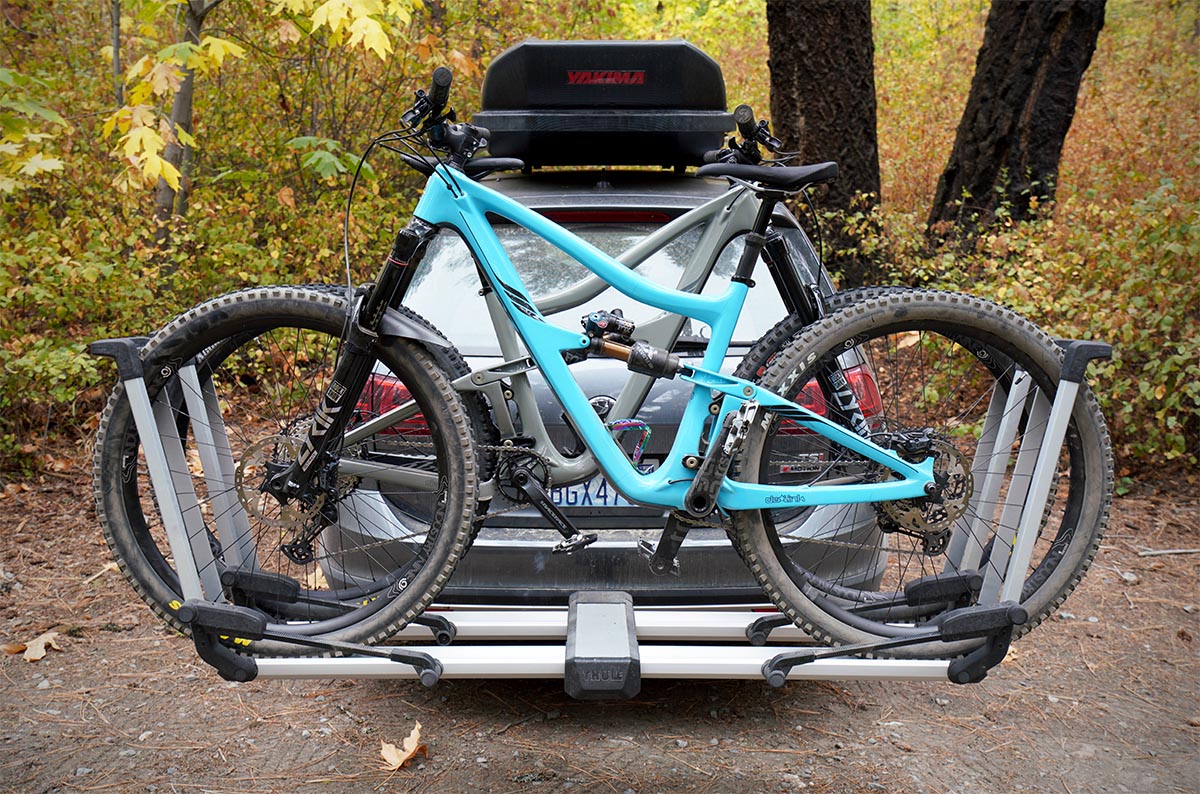
When buying a new trail bike, one of the most commonly asked questions is: Should I buy a hardtail (suspension fork only at the front) or full-suspension (includes both a front suspension fork and rear shock) model? There are a number of factors to consider when making this choice. Are you on a tight budget? Are you just starting out? Are your local trails smooth and with few obstacles? If so, a hardtail is probably the best choice for you. However, should your local terrain be rooty and rocky, or maybe you just like going downhill fast, then a full-suspension rig probably is the better option. This is just the tip of the iceberg, however, and we break down the additional considerations below.

Performance
In terms of overall riding performance, hardtail and full-suspension mountain bikes each come with their fair share of pros and cons. Starting with hardtails, their lower weight and lack of suspension travel makes them fast and easy to pedal quickly. As a result, they excel on long rides and climbs. But should the going get rough—especially on the downhill—a full-suspension bike quickly takes the lead. The added rear suspension helps soak up bumps and offers a much more comfortable ride in general. FS bikes are the weapon of choice for most intermediate to advanced riders. Having said that, full-suspension designs like our top-rated Santa Cruz Hightower typically weigh more, are significantly more expensive, and will not be as efficient at climbing or on non-technical trails.
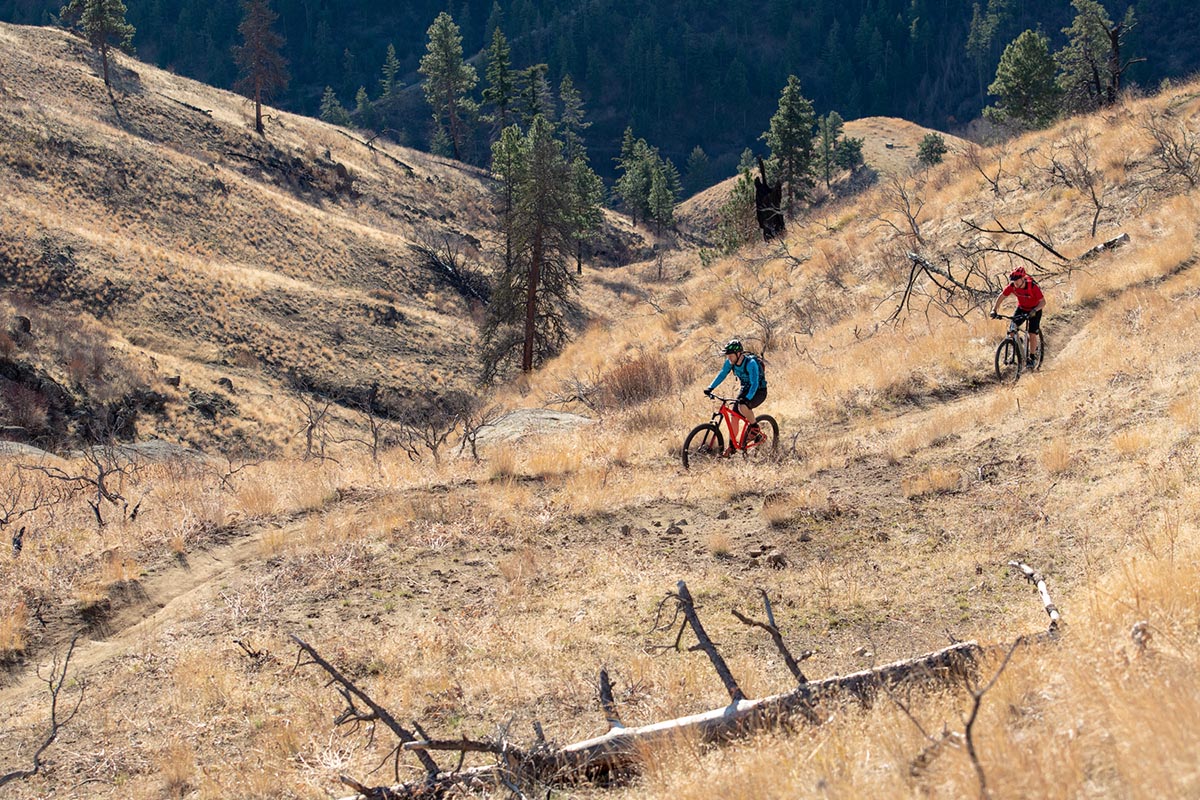
Maintenance
If you’re looking for a simple and low-maintenance bike, then hardtails take the cake. Their lack of rear suspension means they forgo any bushing, bearing, or pivots that generally require extra care and attention. This becomes especially true should you live in a wet and muddy climate, which can wreak havoc on full-suspension bikes if they go unmaintained. Because of these characteristics, it’s not uncommon for dedicated mountain bikers to own a full-suspension bike for summer use and a hardtail for when the trails turn to slop. Bikes like the Salsa Timberjack are able to hold their own against short-travel full-suspension rigs yet are much simpler to keep fresh should you often ride in the rain.

Price
Once again, if a low price is your top priority, then hardtails are the clear choice. Quality full-suspension trail bikes, with their added rear shock and linkage, are simply too complex to design and build on the cheap. From the list above, the $2,999 Ari Cascade Peak Pro is about as low as we’d advise going with a full-suspension design (there are a few just below $2,000 that are suitable as well). Sure, you could certainly spend less than that on a bike from a big-box store, but in reality, it’s going to ride terribly. The parts won’t last, the suspension will be overwhelmed, and you’ll be quickly wishing you bought a lighter and more comfortable hardtail instead.
.jpg)
For 2024, the old 26-inch wheel standard is essentially gone, and most trail mountain bikes are equipped with either 27.5- or 29-inch wheels (occasionally you'll come across “plus” variations of the two sizes, which indicate wider tires). In general, riders focused on a lighter and nimbler style will prefer 27.5, while 29ers are more popular among speed-focused cyclists tackling rougher trails. And there are other considerations—including your height and local terrain—which we cover below.
27.5
Those looking for a playful ride that is easy to maneuver on tight and twisty trails will likely want to choose a 27.5-inch-wheeled bike. This smaller wheel size is lighter, quicker to accelerate, and more responsive to rider inputs—something you’ll especially notice when starting from a slow speed or coming out of corners. Downsides of 27.5-inch trail bikes are that they’re a little more fidgety when you’re riding hard and can get hung up easier than a 29er in particularly rough terrain, but the differences aren’t too drastic. Finally, compared to 29ers, 27.5s are typically a better choice for smaller riders (especially those 5’2” and under): They're less cumbersome, provide a better overall fit, and offer greater control.
.jpg)
29er
29-inch-wheeled mountain bikes, often referred to as “29ers”, are known for their ability to carry momentum down the trail and roll over obstacles with relative ease. While these favorable characteristics were previously sought-after primarily by XC riders, this wheel size has slowly made its way into all disciplines of the sport. 29ers are also known to be more stable than 27.5-inch-wheeled bikes at speed and have a larger tire contact patch with the ground, which translates to an increase in traction. And it's worth noting that in the past, 29-inch-wheeled bikes were marketed to taller riders. However, in recent years, bike companies have made significant progress in trail bike designs, and it’s not uncommon to find riders in the 5’3” range sporting this wheel size. Of course, if you happen to be over 6 feet tall, we can’t help but think you’ll be best-served by a 29er in most cases. For a more detailed breakdown, see our article: 27.5 vs. 29er Mountain Bikes.
.jpg)
Mullet
There's a relatively new fad sweeping the bike world, which is riding with a 29-inch front tire and a 27.5-inch rear tire. Aptly dubbed a “mullet,” it’s as polarizing a design as the ‘70s hairstyle. But in theory, you’re getting the best of both worlds, including the workhorse capability of a 29er combined with the playfulness of a 27.5-inch setup. Climbing can take some getting used to, but fast, downhill cornering is a blast. Many bikers prefer the predictability of a more traditional setup, but the added playfulness and versatility can be a boon for the right rider. From the options above, the Specialized Stumpjumper Evo T-Type and Specialized Turbo Levo Comp are standouts in this category.
There are a number of drivetrain and gearing options currently on the market, and the quality of a given setup often directly correlates with the cost of the bike. On budget-oriented rides like the $599 Co-op Cycles DRT 1.1 (not included here), you’ll find 3 x 7 or 3 x 8 gearing (for a total of 21 or 24 speeds). The “3” indicates the gearing at the front (where you’re pedaling), while the “7” is for the rear cassette. The upside to the design is that you have a wide range of gears at your disposal for anything from steep uphills to fast-paced gravel paths. But it comes with a very significant weight penalty, and it can be a real pain trying to quickly swap between gears at either end of the ratio. As such, every year we see more and more 1X drivetrains that ditch the front derailleur.

For 2024, most quality hardtails and full-suspension rigs—including all of those on our list above—utilize a 1X setup. What you get by only having the gearing at the back is improved ergonomics and efficiency—there’s only one shifter to manage—and less weight. In addition, with budget-friendly designs like the 1 x 12 Shimano Deore, you can still get a very wide gear range without breaking the bank. For riders committing to the sport and planning to tackle steeper terrain, we consider a 1X setup to be a worthy upgrade. And a final note here: SRAM and Shimano dominate the 1X market, and in general, as price goes up, weight goes down and shifting smoothness and reliability improve.
.jpg)
Mountain bike weight is one of the more sought-after numbers for potential buyers, but it can be difficult to nail down (not all manufactures advertise it). The good news is that weight doesn't vary too widely within the trail category, plus it’s typically easy to get a good estimate based on the design. In general, pounds drop as the quality of the materials and price go up. For the most part, the weight decreases are due to nicer components like the drivetrain, suspension fork, and wheels. You’ll also see a drop in weight on high-end bikes when manufacturers utilize carbon fiber frames rather than aluminum. Serious riders will often be willing to spend up for the lighter model, while casual riders or those not planning to cover significant ground can save with a heavier build. Finally, e-mountain bikes are on extreme heavy end of the spectrum—their batteries and complex motors can push them to around 50 pounds.
.jpg)
Electric mountain bikes (also known as e-mountain bikes) are a fairly new and rapidly growing category. As the name would suggest, they feature an electric motor to help propel the bicycle along. Currently, there are three popular classifications of e-bikes: Class 1 is known as pedal assist (AKA pedelec) and requires rider input to engage the motor. This is the most popular form of e-mountain bikes. Class 2 features a throttle and does not require rider input to engage the motor. Class 3 is considered a speed pedelec (it still needs rider input) but features a higher assisted top speed of 28 miles per hour (Class 1 bikes stop assisting at 20 mph).
While electric mountain bikes are certainly fun to ride, they do have a number of downsides. They are typically very heavy (averaging around 50 lb.) and can be cumbersome to transport. And although e-bikes have been very popular in Europe for quite some time, they continue to receive pushback in the United States. There are a number of laws and trail restrictions regarding the use of E-MTBs, so it’s important to check your local rules before heading out on a ride.
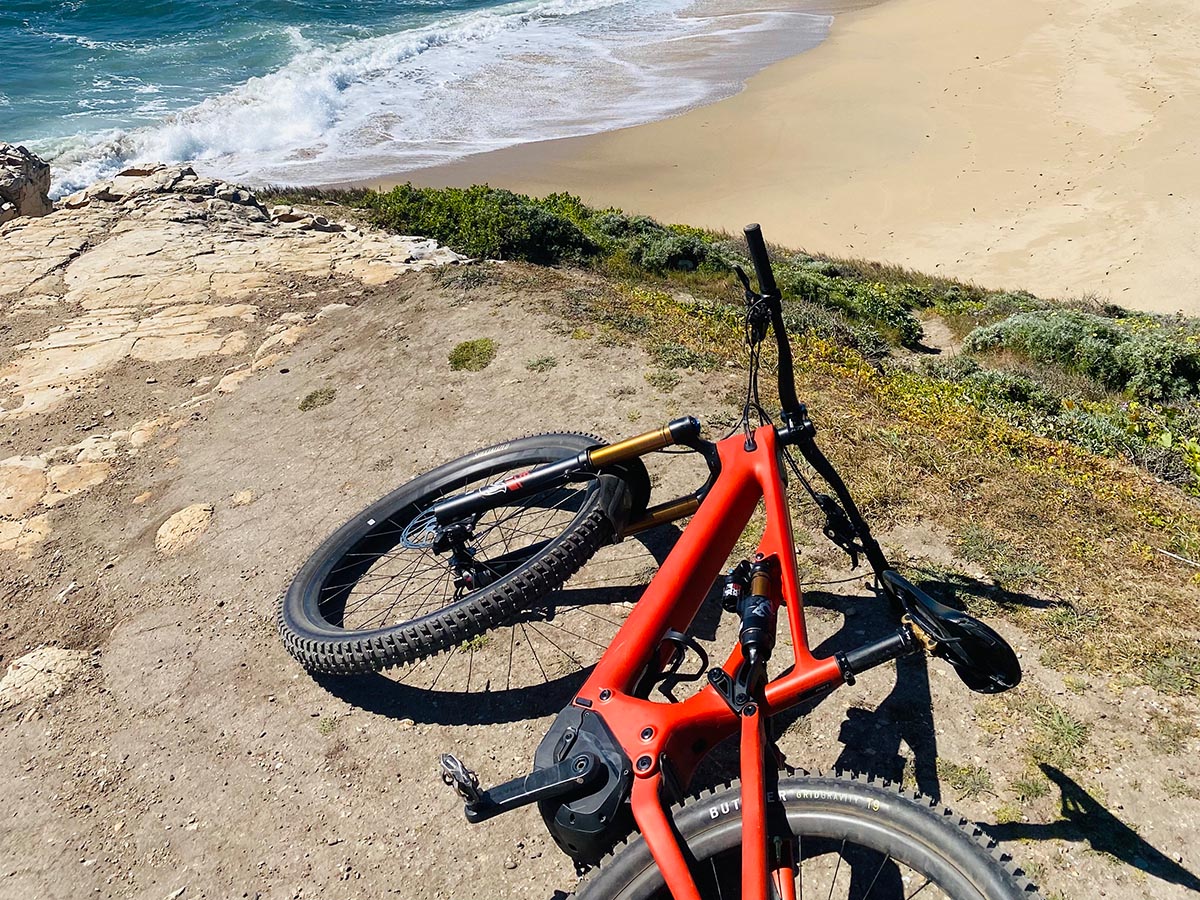
Many trail bikes are made in a unisex style and a range of sizes (typically from “S” to “XL”). This can work well for both men and women, although riders on the shorter end of the spectrum can run into some challenges getting an ideal fit. Some brands like Specialized address this by offering a wider range of sizes within the unisex line. Taking their Stumpjumper Evo as an example, the bike is made in six frame sizes with varying geometry to accommodate different heights. For many women, simply having an array of size options is all they need to get a great fit.
In addition, a number of brands make dedicated women’s mountain bikes. In the past, these mostly have been shrunken-down versions of the unisex models in different colorways. And while that’s still true in some cases—especially on the budget end of the spectrum—many quality brands make women’s-specific trail designs with retuned suspensions, handlebars that are narrower with smaller-diameter grips, and reshaped frames. There also are women’s-only bike brands, including Juliana (Santa Cruz’s sister brand) and Liv (Giant). Liv Cycling in particular really stands out as a leader with a growing collection of XC, trail, and e-mountain bikes for women. In the end, a unisex design like the aforementioned Stumpjumper can be a great pairing for many lady riders, but there are a number of potential benefits in opting for a women’s-specific model.
.jpg)
One of the first questions you should ask yourself when purchasing a trail bike is how much you’re willing to spend. Having an approximate number in mind helps narrow the search and will put you into one of the general categories below. It’s a fairly complex topic overall—and we take a deeper dive in our article on how much you should spend on a mountain bike—but here is where things stand for 2024.
$400-$1,000
This is the bargain-basement price range and reserved for beginners and those who only plan to get out infrequently. Bikes here are almost exclusively hardtails that are suitable for mellow gravel rides and easy, smooth singletrack. However, they’re decidedly heavy, clunky, and less trail-worthy and upgradable than pricier options. If you have intentions of staying in the sport long-term, we’d highly recommend spending slightly up for better components and overall performance. For example, the Salsa Rangefinder Deore 11 29 costs a very palatable $1,199 ($1,099 through REI Co-op) and will far outperform the true clunkers that dominate the sub-$1,000 price range.
.jpg)
$1,000-$3,000
Stepping up into this price range gets you a significantly more singletrack-worthy design. Overall, expect to see three main areas of improvement: Drivetrains will become much more modern, suspension components will offer greater refinement and more adjustments, and overall weight of the bike will greatly decrease. At the lower end of this price spectrum, we advise a hardtail, which will have much better components and weigh significantly less—both important characteristics for having fun. On these bikes, you should expect to see name-brand drivetrains from Shimano and SRAM, as well as quality disc brakes (many also come with a dropper post). However, as you start to creep closer to $2,500, making the switch to a full-suspension bike can certainly be worthwhile. Overall, we consider this a great price point for finding quality and trail-worthy bikes.
$3,000-$6,000
Now we’re into the holy grail of price categories among trail bikes. At the lower end, you’ll find full-suspension aluminum bikes with fully modern parts and geometry. Smooth-operating 1 x 12 drivetrains, quality suspension components from Fox or RockShox, and mostly name-brand parts should be the norm. Close to $5,000, you’ll start to find aluminum bikes with top-of-the-line components, as well as the introduction of carbon fiber-framed bikes. Although $5,000 is unquestionably a lot of money to spend, if you’re set on carbon, be aware that you’ll still be only getting mid-range components in most cases.
.jpg)
$6,000 and Above
Breaking the $6k barrier puts you in the “fully committed” category. Your bike might cost more than your car (we’ve been there), but it’s a dream machine. There’s carbon everywhere—frame, wheels, cranks, handlebars—all in the name of shaving weight. And if money really is no object, there are bikes like Yeti's SB135 T4 XX. Their top-of-the-line version has carbon everything, and then adds in wireless shifting for good measure. The price: $10,000. While certainly outlandish, we can’t help but appreciate the crème de la crème of trail bikes. And the final piece of good news is that the technology that goes into these high-end beasts eventually trickles down into the lower price points.
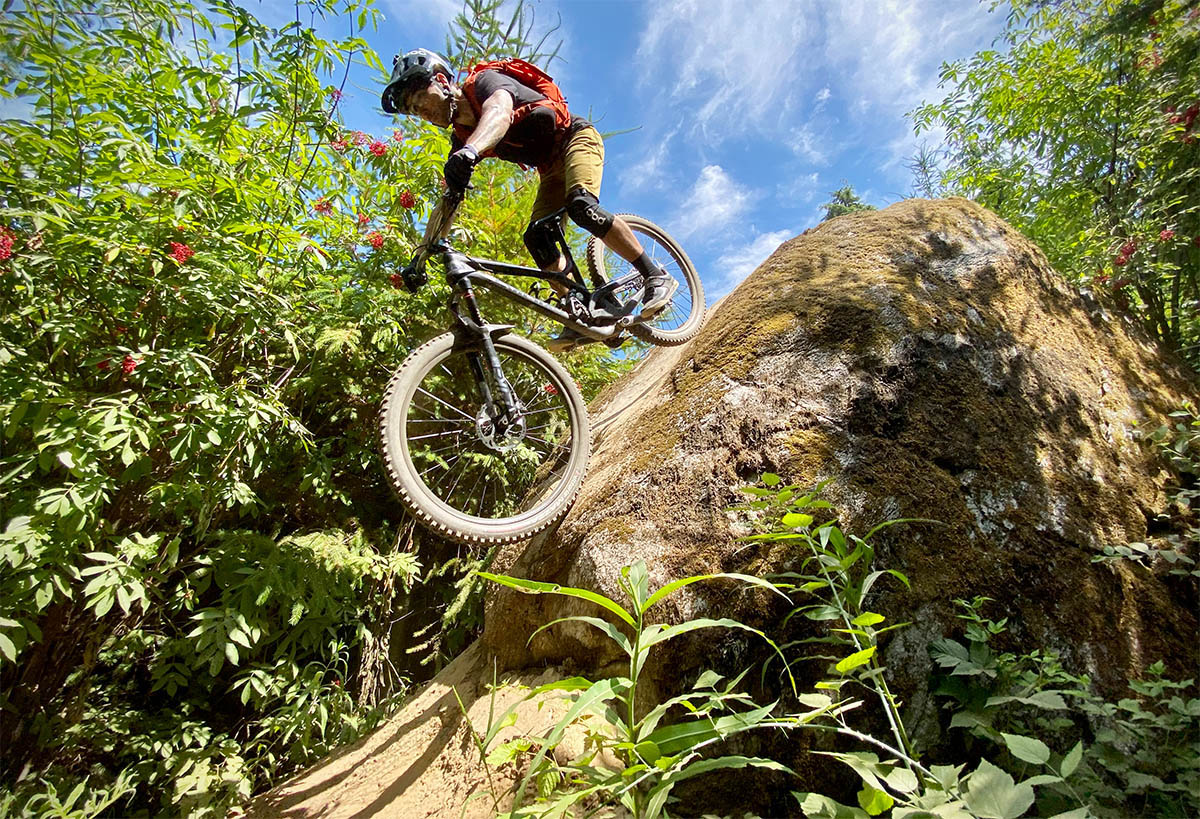
The majority of us do a significant amount of shopping online, so why not do the same when purchasing a mountain bike? They’re certainly more complicated to figure out than a set of dish towels, but there’s a lot of recent movement towards online sales from consumer-direct brands (more on this below), major retailers like REI Co-op and Competitive Cyclist, and even manufacturers themselves like Diamondback. If you’re considering going this route, it’s important to ask yourself a few questions before clicking that buy button. Are you comfortable doing basic assembly and mechanical projects? Will someone be at home to take delivery and sign for your new ride? And, perhaps most importantly, are you comfortable choosing the right size and style of bike without taking a test spin?
One of the most important pieces of the new bike puzzle is getting the correct size, which can be the difference between riding your bike down the hill or wanting to throw it down the hill. Luckily for us, most reputable online retailers and brands provide a significant amount of fit-related information. Size charts are often tailored to specific models, and you’ll then get size recommendation based on your height or inseam length. Taking this a step further, Competitive Cyclist offers one of the most comprehensive fit guides we’ve seen, compiling measurements for your inseam, forearm, lower leg, and more. Taking this detailed approach is one way of ensuring you wind up on a bike that fits you properly.
.jpg)
Once you decide on a trail bike, you need to be prepared for a very large box to arrive on your front porch. From experience, it’s good to know that not all manufacturers will require a signature on delivery, so you’ll want to closely follow the tracking information. The next important piece is the bike’s assembly. The majority of bicycles come mostly put together with instruction on how to finish the build, and it’s not overly complicated for those who have done basic work on bikes in the past or are mechanically inclined. To help, you can find a range of online tutorials from seasoned riders and manufacturers alike. And if all else fails, most bike shops will happily assemble your bike for a fee of around $50 (this can vary).
Consumer-direct brands like Ari, YT Industries, Polygon, Canyon, and Commencal have gained a solid foothold in the U.S. in recent years. The appeal is obvious: By selling straight to you from an online shop, they cut out the middle man (bike shops) and save you a bunch of money. For instance, Ari’s carbon Delano Peak Elite comes in $1,000 less than a similarly equipped Santa Cruz Hightower S ($5,899). What’s the catch? There are plenty of horror stories out there of poor customer service, long lead times for receiving bikes due to stock issues, and the pain of having to ship items back for warranty (instead of being able to just bring it into a shop). That said, we also know of plenty of happy buyers who are riding their dream bikes at a significant discount.
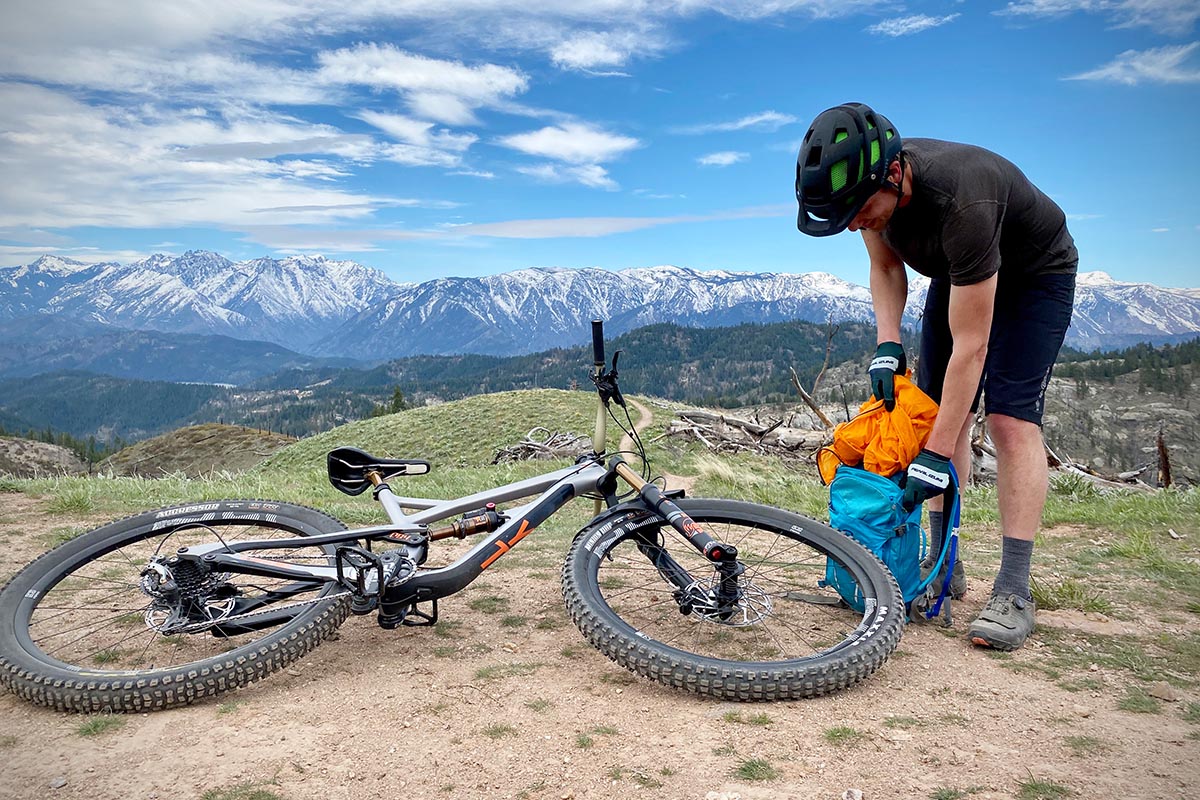
The trail bikes listed above are the latest and greatest in their respective categories, but purchasing a used model is a great way to save and cut down on waste. To start, keep in mind that mountain bike technology has been rapidly evolving even in the past few years, so we recommend picking up a pretty new design. Further, it’s a good idea to closely inspect the bike in person to make sure you’re not buying an unmaintained money pit. With the drivetrain, verify that the chainring teeth are shaped like triangles and less like shark fins. If they look like the latter, it’ll likely need to be replaced. The frame, brake pads, and chain should also be inspected for undue or heavy wear. Finally, see if the rubber seals around the suspension components are cracking or if oil is running on the outside of the fork—both are signs that service is required.
If you’re not comfortable with checking a bike’s mechanical soundness, it’s often worth having a local shop take a look (or you could purchase a former demo bike from a shop, so you can ensure it was properly maintained). Even a modest hardtail can set you back a few hundred dollars, and higher-end models hold their value well enough to justify getting a professional opinion. We recommend calling ahead to make sure they offer the service and that they can fit you in. In the end, used bikes have their place—especially for those just getting into the sport—but it’s a good idea to make an informed, smart decision.
Back to Our Top Mountain Bike Picks Back to Our Mountain Bike Comparison Table